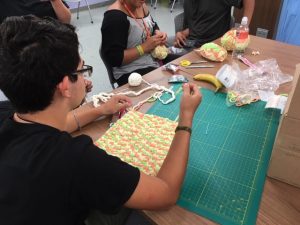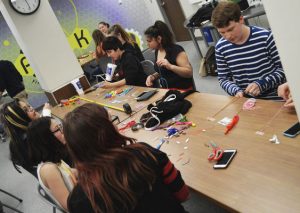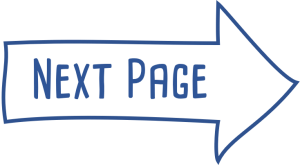by Casey Rawson
Education transforms the lives of individuals and is the foundation for strong, economically vital communities. In the knowledge economy, the library is the learning institution ready to guide and support citizens at every age and level of need.
—Urban Libraries Council
Science. Technology. Engineering. Art. Mathematics. Individually, three of these subjects have long histories in formal K–12 education environments (with technology and engineering being more recent additions to public school curricula). Together, they represent a critical set of literacies that today’s children and teens must possess to fully understand the world in which they live—and the world they will help to create.
While few would argue that STEAM education is not important for children and teens, the reality is that not every young person has access to high quality STEAM resources and teaching through the public school system. Because schools are structured around defined standards and curricula, there are also valuable elements of STEAM education that aren’t currently being taught in formal education environments. Informal learning organizations, such as museums and parks, play a critical role in supporting and complementing more formalized STEAM instruction, but opportunities to learn in these environments are also unevenly distributed. Fortunately, there is another public institution with the potential to address these gaps and provide high-quality STEAM instruction to all children and teens: the public library.
In this book, we argue that far from being “one more thing” that extends the scope of public library work beyond its core mission, STEAM instruction is, in fact, a means for public libraries to enact that core mission. Public librarians and public libraries around the country are already offering incredible STEAM programming, many examples of which will be highlighted in this book. By shifting our thinking to reframe that programming as instruction, we can make our library services more equitable, more empowering, and more impactful.
So what does intentional, equitable, and empowering STEAM instruction look like in the public library? Throughout this book, we will share dozens of real-world examples of public library programs and services that are already exemplifying these characteristics. Let’s begin by considering one extended example: the Make a Difference program series at the La Porte County (Indiana) Public Library.
Spotlight: Make a Difference Series at the La Porte County Public Library
 When La Porte County Public Library opened a makerspace in 2016, Youth Librarian Monicah Fratena knew that she wanted to use the equipment to make a positive difference in the community. Inspired by a YALSA Young Adult Library Symposium session on community service projects in the library, Fratena began asking teen library users about the causes they cared about within their communities. Next, Fratena collaborated with Technology Librarian Pam Okosun to find projects related to those causes that could be made in the makerspace. They settled on six projects and received a grant from the Young Adult Library Services Association and Dollar General to fund the program series, which they called Make a Difference.
When La Porte County Public Library opened a makerspace in 2016, Youth Librarian Monicah Fratena knew that she wanted to use the equipment to make a positive difference in the community. Inspired by a YALSA Young Adult Library Symposium session on community service projects in the library, Fratena began asking teen library users about the causes they cared about within their communities. Next, Fratena collaborated with Technology Librarian Pam Okosun to find projects related to those causes that could be made in the makerspace. They settled on six projects and received a grant from the Young Adult Library Services Association and Dollar General to fund the program series, which they called Make a Difference.
In 2018, the Make a Difference series was launched, and over the next six months, over 250 people participated. While the majority of participants were teens, one of the library’s goals was to create opportunities for intergenerational interaction; so, for some of the events, both younger and older community members took part. Local middle and high school classes were invited to participate in two of the events, which helped the library reach teens who weren’t already library users.
The projects that teens created included rainbow-colored bracelets to be distributed during LGBTQ+ Pride month, chew toys for a local animal shelter, bicycles for local foster children, light-up cards for homebound community members, crochet blankets for premature babies at the local Children’s Hospital, and—their most ambitious project—twenty 3D-printed prosthetic hands, which were developed in collaboration with Enabling the Future (http://enablingthefuture.org/). In some cases, teens were able to hand-deliver the finished products to the community organizations that would put them to use.
The Make a Difference series offers a rich example of a library program that integrates STEAM learning with information and traditional literacy skills in a way that centers equity and inclusion. Fratena reported a range of learning outcomes for the series:
Most importantly, the teens learned empathy and expanded their knowledge of how others live. … At each event, we discussed why we were doing the project, and how the community would benefit. We saw a lot of “lightbulb” moments in the teens during these conversations. Teens learned how to use a variety of tools, [and] they learned project and time management. They learned how to follow in-depth instructions. They learned that failure is okay, as long as they try again to succeed. (Personal communication, March 29, 2019)
These learning outcomes align with those published by YALSA as a guide for teen services planning in public libraries (more on these outcomes below). For example, YALSA’s teen learning outcomes include:
- Teens are able to give back to others and the community.
- Teens are able to leverage digital tools to broaden their perspective.
- Teens are able to practice workforce skills.
All of these learning outcomes were embedded throughout the program series. STEAM concepts and skills were also integrated throughout. For example, engineering concepts and technology were cornerstones of the prosthetic hand project, and the design of both functional (engineering) and beautiful (art) products was key for the blankets and light-up cards.
Fratena’s advice for librarians looking to implement a similar program series is to “talk to your teens. Find out what causes they care about and build the program around that” (personal communication, March 29, 2019). She also encouraged librarians not to be discouraged by the fact that her library had grant funding; many of the projects could have been accomplished with much less money, and some may even be possible to do for free with donated supplies. Overall, Fratena described the program as a “happy success,” adding that for her, the biggest positive was that she “learned how much teens can care about their community.”
As the Make a Difference series demonstrates, STEAM learning can go hand-in-hand with library learning outcomes to create engaging and meaningful programming. But some people have raised a question that needs addressing here before we move on: is education really a core service of public libraries? Some public library staff fear that making our youth-focused programs and services more explicitly instructional could lead to decreased participation among children and teens who come to the library looking for fun.
We would respond to this fear with two counterpoints. First, education in the public library space can absolutely be fun. We have a huge advantage in the educational space compared to formal learning environments in that we are not bound in what we can teach by state standards, curriculum pacing guides, or the looming spectre of standardized tests. That means we have the freedom to teach children and teens what they want to learn, in the ways they want to learn it. Second, instruction is already happening in the public library space – it’s just not always called instruction. The children and teens who come to the public library (physically or virtually) can and do learn in dozens of ways: by reading our resources, interacting with peers and library staff, searching for materials that interest them, participating in our programs, and tinkering in our makerspaces, to name a few. In many cases, those are experiences that have been planned and/or facilitated by a library staff member. In other words, library staff are already causing people to learn new content and skills: they are already educators, even if they would not (yet) embrace that term for themselves.
In recent years, public libraries, library staff, and library professional organizations have acknowledged the instruction already occurring in public libraries by shifting toward a more explicit description of public libraries as active learning environments. Long considered “the people’s university” (even though that phrase suggests an equality of access that public libraries have historically not always reached), the public library’s educational role in past decades was focused almost entirely on the collection: Public libraries provided access to print materials, which anyone could use—or not—to learn about whatever topics interested them. Recently, though, the conversation around education in public libraries has shifted away from access to resources and toward a more active conception of learning—and, by extension, teaching—in these spaces.
For children and teens especially, there is a growing awareness of the potential for public libraries to complement and fill gaps in the educations that youth receive in other formal and informal learning environments. This awareness is reflected in the most recent versions of the Association for Library Services to Children (ALSC) and the Young Adult Library Services Association (YALSA) professional competency documents and in the recently released Teens First: Basic Learning Outcomes document from YALSA, both of which will be discussed more fully in later chapters.
These and other professional organizations (such as the Urban Libraries Council), along with state organizations, individual libraries, practitioners, and researchers, have begun to articulate the “what” of public library instruction through documents, articles, blog posts, conference presentations, and policy statements. Looking across these documents, three broad domains of content and skills have been identified: information literacy, traditional literacy, and dispositions (Curry & Rawson, 2018). Information literacy, which includes digital literacy, focuses on teaching youth how to find, evaluate, use, and share information. In the area of traditional literacy, public librarians “initiate and elevate motivational reading initiatives by using story and personal narrative to engage learners” (American Association of School Librarians, 2017, p.3). Dispositions can be defined as a characteristic attitude, outlook, or habit of mind; these include qualities like empathy, flexibility, and perseverance.
When we examine the what of public library teaching and learning, we see that this is what we might call meta-content: understandings, skills, and dispositions that transcend any particular subject area. This means that the possibilities for teaching this content are virtually endless! For example, consider the YALSA learning outcome “teens are able to engage in personal expression.” “Personal expression” could take dozens of forms, including spoken word poetry, visual art, storytelling, dance, photography, and more. Even once a particular form of personal expression has been identified, there are dozens of ways that public librarians could potentially facilitate teens’ development of that skill. For example, photography could be taught in the context of an ecology program or as part of an intergenerational oral history program series. In more formal learning environments such as public schools, subject area content is the end goal. In the public library, subject area content is the tool through which we learn and teach our meta-content.
So if that’s the case, why STEAM? If we can teach children and teens the “library curriculum” through subject areas public librarians are already more familiar with, such as literature or history, why should we invest in STEAM programs that might push us beyond our own content expertise? And why public libraries—aren’t other informal and nonformal learning environments like parks and museums already addressing STEAM education? The rest of this chapter will explore these questions.
What’s the big deal with STEAM, anyway?
If you’re not (yet!) a fan of STEAM learning, it may seem like you can’t escape talk about its importance. While the rhetoric around STEAM may seem relatively new, this conversation actually dates back to the 1950s, when Cold War fears and the launch of the Russian satellite Sputnik spurred the U.S. government and populace to push for increased and improved science and technology education. Competition with the USSR continued to fuel U.S. innovation in STEM fields through the 1980s (note that at that time, the arts were missing from this area of emphasis). By the 1990s, STEM fields represented a large portion of the U.S. economy, and educational organizations worked alongside state and national governments to develop standards and guidelines that would help to ensure that K–12 students would be prepared to join the STEM workforce. It was in this decade that the acronym STEM first became widely used.
In the early 2000s, growing evidence that the U.S. was falling behind other developed nations in STEM learning and innovation, coupled with the proliferation of the Internet and other technology, led to a new wave of initiatives related to STEM learning. President Barack Obama made STEM learning a key focus area of his presidency by providing funding for STEM education and teacher training.
Finally, in 2010, the Rhode Island School of Design (RISD) led the call to add the arts and design into the STEM conversation. Former RISD President John Maeda argued that the creativity and ingenuity valued in the arts have always been critical to innovation: “Design creates the innovative products and solutions that will propel our economy forward, and artists ask the deep questions about humanity that reveal which way forward actually is” (Maeda, 2012, para. 5). Though some still argue that the addition of the “A” dilutes the importance of STEM (an argument we will address later in this book), there has been general acceptance of the expansion.
Many of the arguments for emphasizing STEAM learning are fundamentally economic in nature; they advocate for STEAM learning as a means to achieve both national and individual prosperity. Other arguments center on STEAM education as a critical equity issue; these arguments point to statistics showing a “leaky pipeline” to STEAM careers for women, people of color and Native people, and other members of marginalized groups. A third argument advocates for STEAM learning as necessary for all people; this argument asserts that STEAM literacy is necessary to understand, think critically about, and help shape our world. One of these arguments may initially stick out to you as being particularly compelling. In this book, we will unpack each of these and argue that all three are intertwined. Collectively, they speak to the continued urgency of STEAM education for all people—including the children and teens who visit our libraries.
Sure, but why public libraries?
In most suburban and urban areas, informal and/or extracurricular STEAM-focused learning environments abound. These include museums, camps, afterschool clubs, parks and zoos, and online resources, among others. So why should public libraries play a role when there are already so many organizations addressing this need?
First, it’s important to note that the existence of informal and extracurricular STEAM learning environments does not mean that every child and teen has access to these environments. Rural youth are less likely to have access to both physical and digital STEAM learning environments. For example, only 26 percent of U.S. museums are located in rural areas (American Alliance of Museums, n.d.), and an estimated 14 million rural Americans and 1.2 million Americans living on Native tribal lands lack mobile broadband service (Federal Communications Commission, 2018). Cost is also an issue for many families who might otherwise take advantage of extracurricular STEAM opportunities. The majority of U.S. museums charge admission fees (American Alliance of Museums, n.d.), home Internet access averages $60 per month (Dilley, 2018), and camps and afterschool clubs can cost families hundreds, if not thousands, of dollars (Gellman, 2018).
Public libraries, in contrast, offer their services for free (or at least without direct costs) and are much more geographically accessible compared to other informal and extracurricular STEAM learning sites. A 2015 study found that more than 90 percent of the U.S. population lives within five miles of a public library, and roughly two-thirds live within two miles (Donnelly, 2015). Because of their relative ubiquity and their public nature, the Aspen Institute described public libraries as “a key strand in the social safety net,” adding that “public libraries provide an important lifeline to jobs, educational opportunities, literacy, health resources and government and community services, especially for immigrants and disadvantaged populations” (Garner, 2014, p. iv). Thus, public libraries are ideal sites not only to engage youth in general in STEAM learning but also to engage marginalized youth in particular.
Another reason that public libraries should play a role in STEAM learning is that the content and skills we already teach youth—information literacy, traditional literacy, and dispositions—align naturally with STEAM learning. For example, one of YALSA’s teen learning outcomes is “teens are able to experiment, prototype, and test ideas,” a theme that runs through formal STEAM curricula and standards documents for all age levels. Like library instruction, much of STEAM instruction is focused on process and practices rather than memorizing facts. For example, a common theme of library instruction is information evaluation. This is also a key foundation of the Next Generation Science Standards, which list “obtaining, evaluating, and communicating information” among their eight essential practices of science and engineering (Next Generation Science Standards, 2013). Technology is already a focus of many library programs and services, so existing public library learning opportunities related to tech and digital literacy have already paved the way for more extensive STEAM instruction.
At this point, it’s important to note that advocating for STEAM instruction in public libraries is not the same as advocating for public librarians to become STEAM content experts. R. David Lankes, Director of the University of South Carolina’s School of Library and Information Science, noted that librarians “cannot be all things to all people,” and that expecting them to gain STEAM content expertise would spread them too thin (Lankes, 2015, p. 2). Instead, Lankes argued that public librarians can and should become facilitators of STEAM learning by developing programming that leverages community STEAM expertise and by leading programs that focus on collaborative construction of STEAM knowledge. Public librarians do not need to teach STEAM content and skills directly; instead, we can use STEAM content and skills to teach our library curriculum. This idea will be explored more fully in the next chapter.
What you’ll find in this book
This book is intended to serve as a primer for public library staff who are interested in integrating more STEAM instruction into their library programs and services. In Chapter 1, we will dig deeper into the role of the public library in STEAM education and the steps public library staff can take to ease into this work – especially public library staff who don’t consider themselves to be “science and math people.” In Chapter 2, we’ll take a big-picture look at STEAM before diving into its individual components in Chapters 3 through 7.
The second half of the book will tackle topics and issues that will assist public library staff in building a strong STEAM instructional program in their library: makerspaces (Chapter 8), instructional design (Chapter 9), equity and inclusion (Chapter 10), community partnerships (Chapter 11), and assessment and evaluation (Chapter 12). Each chapter includes real-world examples that highlight how public libraries across the United States are already putting STEAM instruction into action. We will conclude by summarizing and synthesizing the book’s takeaways and suggesting future directions for STEAM instruction in the public library space.
References
American Alliance of Museums (n.d.). Museum facts and data. Retrieved from https://www.aam-us.org/programs/about-museums/museum-facts-data/#_ednref21
Dilley, J. (2018). How much should I be paying for high-speed internet? Retrieved from https://www.highspeedinternet.com/resources/how-much-should-i-be-paying-for-high-speed-internet-resource
Donnelly, F. P. (2015). Regional variations in average distance to public libraries in the United States. Library & Information Science Research, 37(4), 280-289.
Federal Communications Commission (2018). 2018 broadband deployment report. Retrieved from https://www.fcc.gov/reports-research/reports/broadband-progress-reports/2018-broadband-deployment-report
Garner, A.K. (2014). Rising to the challenge: Re-envisioning public libraries: A report of the Aspen Institute dialogue on public libraries. Retrieved from http://csreports.aspeninstitute.org/documents/AspenLibrariesReport.pdf
Gellman, L. (2018). Teaching kids to code during the summer – for $1,000 a week. The Atlantic. Retrieved from https://www.theatlantic.com/business/archive/2018/08/coding-camps/566333/
Lankes, R. D. (2015). Expect more: Why libraries cannot become STEM educators. Public libraries & STEM: A national conference on current trends and future directions. Retrieved from http://ncil.spacescience.org/images/papers/Lankes_Expect%20More.pdf
Maeda, J. (2012). STEM to STEAM: Art in K-12 Is key to building a strong economy. Retrieved from https://www.edutopia.org/blog/stem-to-steam-strengthens-economy-john-maeda
Next Generation Science Standards (2013). Appendix F – Science and Engineering Practices in the NGSS. Retrieved from https://www.nextgenscience.org/sites/default/files/resource/files/Appendix%20F%20%20Science%20and%20Engineering%20Practices%20in%20the%20NGSS%20-%20FINAL%20060513.pdf


